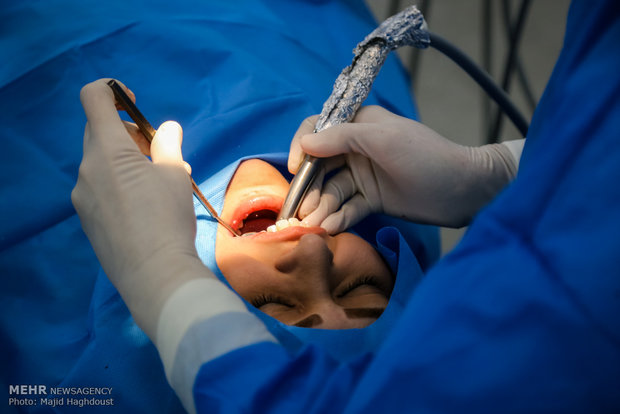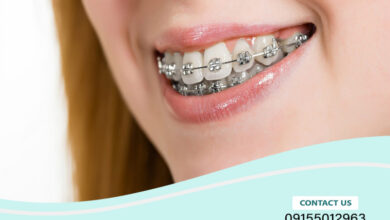
Dental implant offer many solutions for people who have lost one or more teeth, and who may face the possibility of losing all their teeth at some point. Dental implants are like high-tech artificial tooth roots. They are placed under the gums in the jaw bone and can be used to anchor a single tooth, multiple teeth or a full set of teeth.
Until dental implants arrived on the scene, dentists were limited to replacing teeth with tooth-supported bridges, partial dentures or full dentures. With dental implants, single teeth can now be replaced with a single implant. However, you don’t always have to have one implant per tooth. Multiple teeth can be replaced with a select number of well-positioned implants. Often, a full set of upper or lower fixed teeth can be replaced with the support of four to eight dental implants.

When many natural teeth are missing or diseased, an often-proposed treatment is to replace the entire set of upper or lower teeth—including the few that are still viable. This is a proven and predictable solution. However, it’s sometimes possible (and better) to move toward total tooth replacement in stages rather than all at once.
The Appeal of Staged Treatment
A gradual transition to total tooth replacement can be more appealing to people who are on a tighter budget as well as those who still have a number of good natural teeth that they want to keep until replacement is unavoidable. In this case, there are several options that can be recommended.
For example, if the person doesn’t want to wear removable dentures (complete or partial), but it’s possible their teeth may eventually fail, they can start with selective placement of single implant teeth. Or they may go with implant dental bridges: a partial row of prosthetic teeth attached to implants. Later, dental implants in strategic locations can be repurposed from supporting a single tooth or bridge to supporting a full set of upper or lower teeth.
Then there are some people who already have a removable partial denture: one or more artificial teeth on a metal or plastic base that attaches to remaining natural teeth and can be easily removed from the mouth. They are comfortable with this and want to preserve their remaining healthy teeth for as long as possible.
But when one or more of those natural teeth must be extracted (removed) due to damage or disease, it can create a dilemma: Should they now have the remaining healthy teeth removed along with the diseased ones and get a full upper or lower set of replacement teeth, with perhaps four to eight implants? Or does it make more sense for them to keep using a removable denture held in place by one or two implants, and possibly move to a full-arch replacement in the future? As we consider this question, let’s take a closer look at staged transition to total tooth replacement.
?Why Dental Implant
The benefits of dental implants for tooth replacement are well known: They offer a strong, durable support for lifelike replacement teeth that can last decades; they allow people to bite, chew and speak without impairment or embarrassment; and they minimize any bone loss from occurring in the area of the jaw where they are placed, which in turn helps preserve facial support and maintain the structure of the jaw bone. That’s why a dentist’s first recommendation for fixing missing or hopelessly damaged teeth is often a solution that uses implants—in the case of replacing all the teeth on the upper or lower teeth, for example, a non-removable (fixed) denture is held in place by 4 to 8 implants. But this may not be the only option.
A Conservative Approach
When it’s appropriate, instead of moving immediately to replace all the upper or lower teeth, I offer my patients the option of having just one or two dental implants placed at strategic locations in the jaw. These implants can later be used to help anchor a full-arch tooth replacement. But for now, the patient’s existing partial dentures (or new ones of a similar type) can be securely anchored to the new implant on one side, and the natural teeth on the other. This gives the denture all the support it needs to function properly for eating and speaking, and at the same time avoids the removal of natural teeth that are still healthy. This solution is as minimally invasive as possible. It’s also far less costly—which is a big consideration for many people.
Strategic Tooth Replacement
Here’s how placing even one or two dental implants at strategic points in the mouth helps plan for the future: With just one implant already in place, only one more is usually needed to support a basic lower full “overdenture”—a removable denture that is more secure than a traditional denture because it’s held in place by implants. This is a functional and economical option that works for many people. Some people, however, prefer a fixed (non-removable) denture because it feels more like having natural teeth again. In that situation, four or more implants will often provide the necessary support, including those already in place.
What’s more, an implant that’s already in place helps preserve the jawbone in that area, so there should be less need for bone grafting. The placement of implants in certain key areas—near the canines or premolars, for example—can help achieve a more favorable result years down the road. The implant procedure is also generally easier with relatively younger, healthier people.
dental implant
Let’s look at an actual case where this comes into play. I had a patient who was satisfied with her partial denture but had fractured a critical canine tooth that now needed to be extracted. At this point, making her another partial denture supported by a tooth near the front of her mouth wasn’t a good option because in time the denture would loosen the front teeth. In addition, she didn’t want to undergo the process of removing and replacing all of her bottom teeth right away.
So instead, we removed the broken canine and replaced it with an implant. Then we made her a partial denture that attaches to the implant on one side and to a natural tooth on the other side. It’s a minimally invasive treatment that saved her remaining natural teeth, and she’s happy with it. Down the road, if her other teeth fail, she would need just one more implant in order to transition to a basic implant-supported overdenture, or three or more for a fixed denture.
One Stage at a Time
One of the biggest benefits of staged implant placement is that it lets us plan for the future: not just five years away, but ten or even fifteen. I have found that the timely placement of just one or two implants allows needed dental work to fit better into my patients’ lives—taking into account their time, their health and their financial situation. And while we don’t know what the future holds, we can prepare for any eventuality with these strategically placed implants.
As dentists, our goal is to help patients achieve a lifetime of good oral health, which includes eating well, smiling without embarrassment and speaking properly. Dental implants have helped countless people with missing teeth enjoy these benefits. But it’s important to remember that there’s no one-size-fits-all solution to dental issues. Just as each person is an individual, each problem may have more than one good answer. So be sure to talk to your dentist about all of your options for tooth replacement; he or she can help guide you toward the ones that are right for you.
related article: dental leminate
reference : klick here




